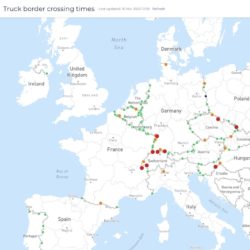Real-time visibility gives DS Smith a tighter grip on paper flows

Packaging producer DS Smith has installed Sixfold’s tool to gain real-time insight into its transport flows. During a recent webinar by Supply Chain Media in collaboration with Sixfold and Transporeon, DS Smith’s Head of Logistics Operations – Group Procurement Petra Lippertova explained how this tool helps the company to save costs: “Transport visibility is not just about tracking shipments, but also about understanding truck dwell times at our paper mills. This allows us to reduce waiting times.”
By Marcel te Lindert
Rising transportation costs are Petra Lippertova’s biggest challenge right now. “There is 15 to 20 percent less transport capacity available on today’s market than in 2019,” she said. This has further increased the pressure on transport costs. “We need a tighter grip on transport flows to get costs back to pre-pandemic levels. Data-driven decision-making helps us to achieve that.”
400 million kilometres
The London-based company DS Smith mainly produces cardboard boxes and covers much of the paper chain, including paper recycling and paper manufacturing. Its 5,000 suppliers range from manufacturers of chemicals such as ink to waste-paper collection companies. Its portfolio of 4,000 customers, spread across 50 countries, includes leading names such as Amazon, Nestlé and automotive companies. “Basically we can sell to anyone who needs cardboard-based packaging. Besides supplying the packaging, we also collect waste paper which results in our carriers covering a total of 400 million kilometres per year. That’s 500 trips to the moon and back!” Lippertova said.
DS Smith’s supply chain is quite complex. Real-time visibility into transport is crucial for a streamlined operation, but that was severely lacking at DS Smith until recently. The company has multiple ERP and TMS systems, so the availability of delivery information left a lot to be desired. In addition, the company works with a large number of carriers, all with their own telematics systems and tracking and tracing solutions, which makes it difficult to keep customers well informed. “And customers obviously like to know when they can expect their shipment,” stated Lippertova.
Avoiding production downtime
DS Smith had actually decided to work with Estonian start-up Sixfold before the pandemic hit. The company had developed its own solution for real-time visibility, which has since been added to the Transporeon portfolio. “When the pandemic broke out, the implementation was not yet at a stage where we could use the tool for data-driven decisions to optimize the entire supply chain, but Sixfold did help us gain insight into the situation at Europe’s internal borders. For example, if there was a 48-hour delay somewhere, we knew that we had to get more goods on the road to avoid production downtime.”
According to Lippertova, the visibility tool is definitely going to help the company keep a tighter grip on rising transport costs: “We’re now investigating two possible applications. First of all, transport visibility is not just about tracking shipments, but also about understanding the time needed for loading and unloading. The longer that takes, the higher the costs – even though we can charge customers for waiting times. In addition, we’re looking at whether we can improve the consolidation of shipments. As mentioned, besides supplying packaging we also collect waste paper. We can make some major gains if we can combine those flows to and from our paper mills.”
Eliminating the human factor
Lippertova has been working in the transportation industry for over 26 years, so she remembers the days when planners used to have to call and text-message truck drivers to get any insight into the shipment status. “Ideally, we want a solution that eliminates the human factor. That’s possible with a platform like Sixfold, which is integrated with carriers’ telematics systems. Sixfold retrieves the data without anyone having to intervene. We only use an additional app for tracking and tracing if a vehicle isn’t equipped with the right hardware or there isn’t enough time to connect the vehicle to the platform.”
The most important data that DS Smith obtains is the current position of each truck and the estimated time of arrival. “That helps us to optimize transport flows and reduce empty kilometres. In addition, we measure the distances driven, which is useful for identifying deviations from recommended routes and for getting better insight into things that happen along the way. We can also calculate the emissions based on the actual kilometres driven. Lastly, we measure dwell times, which enables us to reduce waiting times and improve the deployment of our trucks,” explained Lippertova. She revealed a heatmap showing truck locations in the yard of one of the paper mills. “This allows us to optimize processes in the yard. If we see that a truck is delayed by an hour, we can change the dock planning and give another truck priority.”
Spot market
In autumn 2020, Sixfold’s tool was integrated with Transporeon’s platform for matching transport supply and demand. So far, DS Smith has not made much use of the spot market, Lippertova explained: “It’s great that we can see which carriers are nearby and available, but we prefer to use the technology for our own regular group of carriers. We can’t – and don’t want to – use just any carrier. For example, how are the costs and benefits shared if that carrier also takes shipments for other clients? We also have to be careful with regard to quality. Does the carrier comply with our rules? And is it set up for self-billing? Because of the risks involved, we want to minimize our use of the spot market; it accounts for a maximum of 15% of our shipments.”










